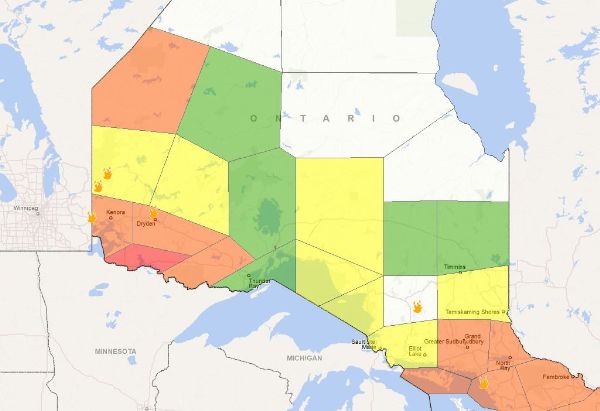THUNDER BAY – Multiple consecutive years of “relatively quiet” forest fire seasons could set the stage for massive wildfires, warns a forest fire ecology management professor at Lakehead University.
As raging blazes in northern Alberta leave widespread destruction in their wake, Jian Wang said the last significantly active forest fire season in Ontario was 2011, when more than 600,000 hectares of land was burned during a nearly unprecedented year.
Wang said fires are a natural, cyclical process that regenerate forests and help remove dead trees. When there is a stretch where fire activity is below average, which leaves more fuel for future wildfires.
So far it has been a slow start to the year in Ontario with 68 reported fires, well below the 10-year average of 98 year-to-date and 104 in 2015.
While it’s very difficult in April and May to predict future fires, conditions are shaping up to create the potential for an active year.
“Usually if you get like this winter with not a lot of snow and the snow melts relatively fast and it dries out,” Wang said.
“Currently we have a very dry environment with most of the snow gone and all top layers start to dry out very fast, especially when we have (temperatures) like 20C.”
Similar weather conditions, where there was very little winter snowfall combined with a quick melt and scorching, unseasonably hot early May temperatures over 30C are attributed to how in a matter of days a small brush fire escalated to one of the costliest wildfires in Canadian history, forcing the near complete evacuation of a city of 80,000 people.
Thunder Bay Fire Rescue chief John Hay said locally there are plans in place to deal with disasters, though the situation in Fort McMurray would be a worst case scenario.

“I don’t think communities are prepared for the scale. We don’t have a contingency plan to evacuate 110,000 people in a day. No one is able to do that,” Hay said.
“What’s happening in Fort McMurray, nobody plans on that happening. What they do is they put their talents and their smart people in place and they do the best for the community and the people during those events. I’m comfortable we have enough talent and smart people that we would be able to make the right choices.”
Wang said geographical factors in Northwestern Ontario, such as shallow soil on the Canadian Shield that leads to quick drying conditions when there is a lack of rain, as well as prevalence of particularly flammable conifer trees such as jack pine, black spruce and balsam fir, make the region prone to forest fires.
He said management of forests, including the use of prescribed burns, could limit the spread of future fires by eliminating excess fuel. He said areas where properties are located close to tree lines could be vulnerable in the event of a wildfire.
Similar circumstances were seen in Alberta, where homes situated right on the edge of the forest were consumed as the fire jumped into residential areas, where in some neighbourhoods more than 70 per cent of homes were destroyed.
Locally, emergency management officials monitor disaster situations to learn about how to prepare in the event they were to happen in Thunder Bay.
“We can study what’s happening in other communities. We’ve studied Great Slave Lake, Kelowna, Timmins, Elliott Lake and our own flood, we’ve studied that and looked at best practices for us, best principles on what to work on and pitfalls to try to avoid,” Hay said.
“I’m comfortable we would make the right choices if a big event were to happen.”
